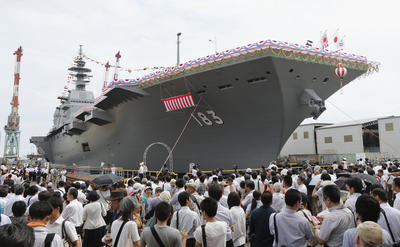The Izumo’s size (and the absence of a catapult and arresting gear) suggests, however, that the only fighter jets that can realistically be launched or recovered from the Izumo are those with short take-off vertical landing capabilities. The only candidate to fill such a role would be the ‘B’ variant of the F-35 Lightning II multi-role fighter.
While the Japanese government has ordered 42 of the conventional take-off and landing ‘A’ variant of the F-35 for the Air Self-Defence Force, the MSDF has no plans to purchase the F-35B. Assertions that the Izumo could ‘easily and swiftly’ be converted into a conventional aircraft carrier also ignore the complexity of Japanese politico-bureaucratic and defence planning processes related to actually getting an F-35B onto an MSDF ship. No self-respecting bureaucratic organisation would invest in a $1.2 billion piece of hardware specifically for the purpose of launching jump jets that may not materialise for many years, if at all.
The Izumo also conspicuously lacks a ski-jump, which limits the amount of fuel and armaments that can be loaded onto an F-35B. It has no angled flight-deck allowing for smooth and simultaneous launch and recovery missions. The Izumo is also too small to accommodate more than a handful of F-35Bs. As an offensive strike carrier, it is decisively weak.
However, the Izumo could be used as a carrier of aircraft in future, raising the question of whether the Izumo is unconstitutional. This issue, however, is often misunderstood: Japan’s constitution does not explicitly ban specific capabilities, offensive or otherwise. What the constitution explicitly bans is the possession of ‘war potential’ (senryoku). There are three technical issues that must be discussed in this context. They are central to understanding how the ban on war potential has been interpreted and implemented as part of the ‘defensive-orientated defense’ (senshu bouei) policy that Japan has embraced since independence in 1952, and officially adopted in 1957.
First, on the basis of international treaties and supporting documents, the Japanese government understands that the proscribed potential to wage ‘war’ as a means of ‘settling international disputes’ refers to the potential to engage in war to invade other countries, and not self-defence. Second, the Japanese government interprets ‘war potential’ as referring to the total strength of the Self-Defence Forces, and not whether a given capability is mostly offensive or defensive.
Third, and most critically, ‘war potential’ is not seen as an unchanging, absolute level of military capability. It is interpreted relative to international conditions, the geostrategic nature of threats facing Japan, and the level of military strength able to be deployed against Japan (measured by numerical quantity and technological quality). Consequently, what is considered the possession of ‘war potential’ in one period of time may not be considered the possession of ‘war potential’ in another.
The MSDF’s current naval capabilities, assuming less technological sophistication, may well have approximated ‘war potential’ in the early 1960s, when China had no naval capabilities to speak of and the USSR had yet to modernise its Pacific Fleet. However, with the blue water modernisation of the USSR/Russian and Chinese navies since 1965 and 1985 respectively, Japan now has significant motivation to transport helicopters to its maritime extremities, particularly for the purpose of anti-submarine warfare. The MSDF’s helicopter carriers will also play an important role in its fleet structure as command-and-control assets, with one carrier being envisioned for each of Japan’s four escort flotillas tasked with ensuring the integrity of Japan’s Sea Lines of Communication in conflict situations. Along with other similar assets they also play an underreported role in humanitarian assistance and disaster relief operations. In fact, very few sensationalist English-language media reports have even bothered to mention that the Izumo boasts an impressive state-of-the-art 35-bed hospital and surgical suite, with accommodation for up to 450 passengers.
Ultimately, only one kind of capability is understood to be proscribed by the constitution — that of exclusively offensive capabilities. These are capabilities that have no value in defending Japan, but that have a specific use in assailing and systematically destroying the civilian and wider military infrastructure of another country. Japan’s helicopter carriers are, however, extremely useful for Japan’s defence and wellbeing, and not particularly useful for assailing the civilian and military infrastructure of other nations, especially given the military strength of other Northeast Asian states. China is thus likely to be most concerned about the Izumo enhancing Japan’s ability to check Chinese naval power projection into Japan’s maritime defensive perimeter, rather than the possibility of it projecting military power onto the Chinese mainland.
Corey Wallace is a lecturer and professional teaching fellow at the University of Auckland. A longer version of this article can be found on the author’s blog, Japan Security Watch.


I very much enjoyed this article, informative and to the point.
In relation to the question of war potential and offensive capabilities, it is also worth reminding ourselves that already in early 2000s versions of the Japanese MoD defence white papers, Japanese officials made clear distinctions between ‘tactical’ and ‘offensive’ carriers, the latter being considered platforms for extended fleet air defence, and therefore in principle not against the content of the constitution.
See:
http://www.mod.go.jp/e/publ/w_paper/pdf/2006/2-1-1.pdf (p.93)
For those interested in the controversy around the name ‘Izumo’, I would suggest my own piece appeared on the Asahi:
http://ajw.asahi.com/article/forum/politics_and_economy/east_asia/AJ201308220044
Thanks again for this most interesting piece,
Alessio
Apologies: a small typo on the previous post.
The sentence ‘the latter being considered platforms for…’
should read ‘the former being considered platforms for…’
Regards, A